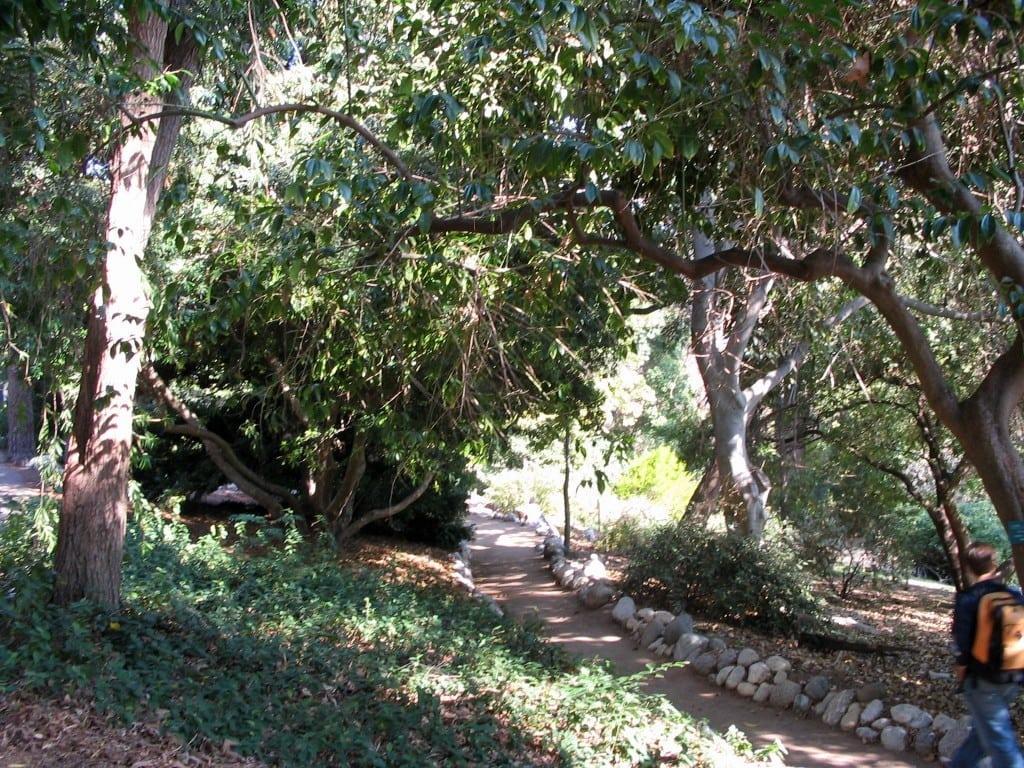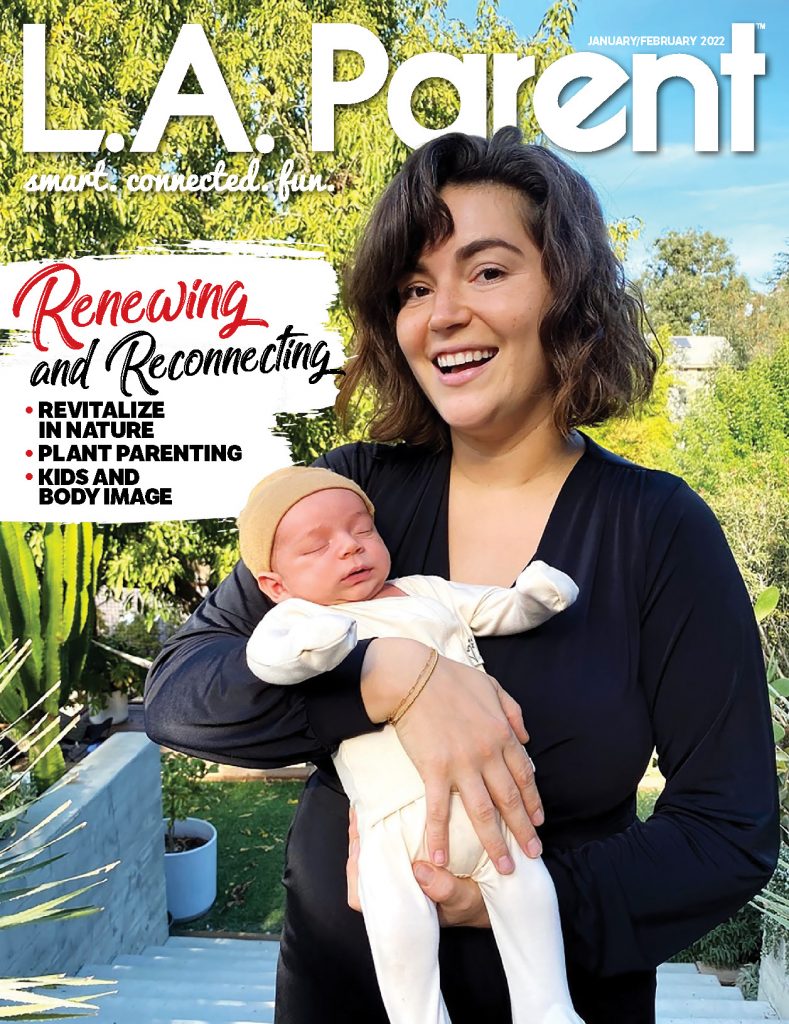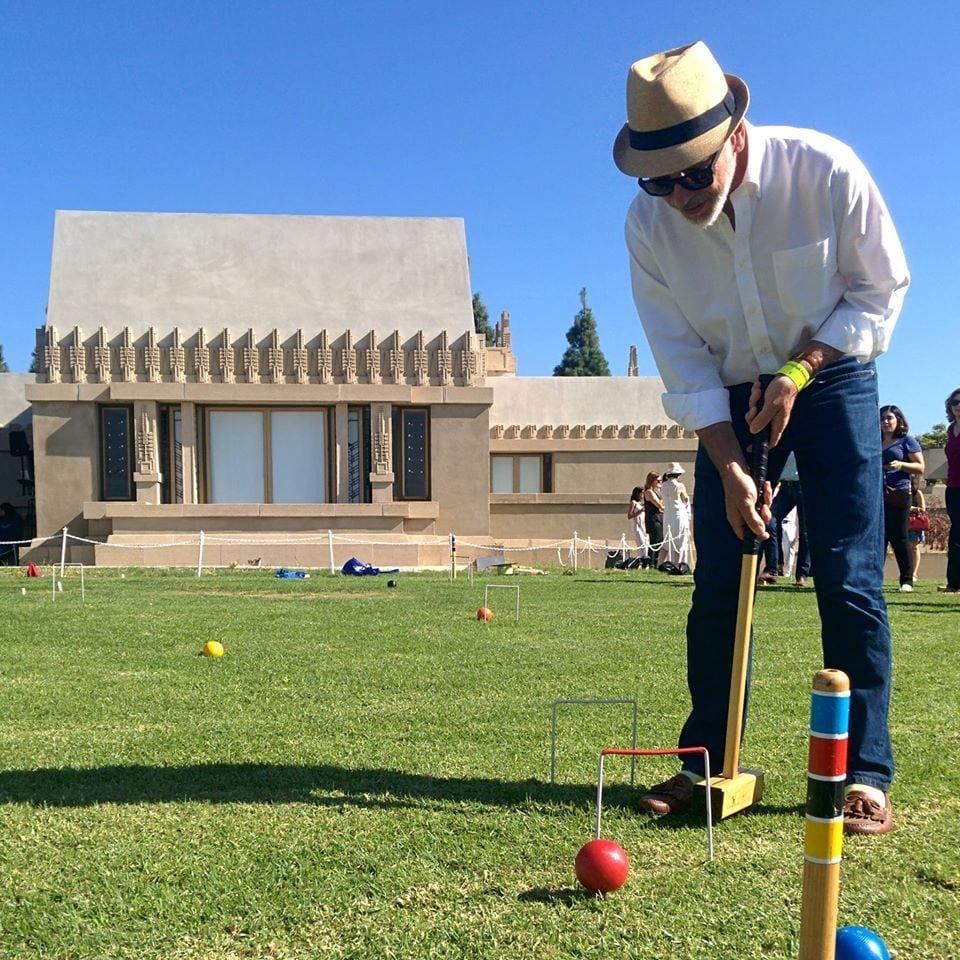Spring is upon us, and it’s a great time to get out and remember why we like the sun. It makes good things grow.
Big Garden On Campus

Matthias Botanical Garden takes up more than seven acres at the edge of the sprawling UCLA campus in Westwood.
That’s true even in some of our most urban spaces. At the southeast edge of the sprawling UCLA campus in Westwood, for instance, lies the UCLA Life Sciences Mathias Botanical Garden. Occupying more than seven acres in a natural ravine, the garden has been there since the campus was founded in 1919. “It’s a very beautiful natural place,” says Director of Programs Wendy Morris.
Morris suggests bringing your family around 10 a.m. and starting with a quick walk through the entire garden, then choosing one of the many benches sprinkled throughout for a break. “Have a snack and just listen to the birds and smell the flowers, then go back to visit the parts you liked the best,” she says.
One of the things Morris likes best is the bromeliad section. “The tiny flower is down the very center of what we think is the flower,” she says, adding that bromeliads come in many shapes and colors. In spring, the California natives are also in bloom, as is the “habitat bed,” which showcases plants that attract bees, butterflies and hummingbirds. And don’t miss the koi and red-eared sliders in the stream. “Everybody loves seeing the turtles basking in the sun,” says Morris.
The garden boasts plants from all over the world, including some you might not see elsewhere. The botanically inclined can learn about them at the one-hour drop-in guided tour offered at 1 p.m. the first Saturday of each month, or by pulling together a group of eight or more and reserving a private tour. “At the end of the walk, you’ll feel like you’ve gone to 10 gardens,” says Morris. But if you still have some energy, you can walk over to the UCLA student union to find out about other activities on campus that day.
Mathias Botanical Garden, UCLA Campus, 777 Tiverton Dr., L.A.; www.botgard.ucla.edu. Open 8 a.m.-5 p.m. Mon.-Fri., 8 a.m.-4 p.m. Sat.-Sun. Closed on university holidays. Admission is free.
High On a Hill
High on the crest of Olive Hill in east Hollywood, overlooking the city of Los Angeles, Barnsdall Art Park offers a different kind of experience that blends the natural and the cultural.
Its centerpiece is Hollyhock House, the iconic historic home designed by architect Frank Lloyd Wright. You can take a self-guided tour (free for kids under 12 accompanied by a paying adult) of the house, which was completed in 1921 and will be of interest to older kids who can appreciate the idea of life in another era.
Fun for all ages are the free Barnsdall Art Sundays from 10 a.m.-noon weekly at the nearby Junior Art Center. Registration for the center’s eight-week spring session of paid art classes for children and teens will begin March 29. Class offerings cover everything from drawing and painting to sculpture, music, photography, theater and computer graphics.
For those more interested in looking at art than in making it, the Los Angeles Municipal Art Gallery also stands on the site. The current exhibition, “SKIN,” brings together the work of 36 contemporary artists to inspire discussions about race and identity. A community arts workshop March 5, which gallery curator Isabelle Lutterodt recommends for ages 14 and up, will explore “Finding Diversity.”
For the whole family, the park itself – with a remnant of the original olive grove planted on the site around the turn of the 20th century – offers a chance to feel a part of the city. The grounds are open daily beginning at 5 a.m., and you can picnic on the lawn and take in the view, which is especially lovely at sunrise and sunset. “I love going to our great lawn,” says Lutterodt. “I love going there and just looking out at the city. You have nearly a 360-degree view of the city of L.A. You can see all the promise and possibilities.”
Barnsdall Art Park, 4800 Hollywood Blvd., L.A.; www.barnsdall.org. Park hours: 5 a.m.-10 p.m. daily. Hollyhock House hours: 11 a.m.-3 p.m. Thurs.-Sun. L.A. Municipal Art Gallery hours: noon-5 p.m. Thurs.-Sun. Barnsdall Art Center hours: 9 a.m.-6 p.m. Mon.-Fri., 9 a.m.-5 p.m. Sat.-Sun. Admission free, class fees extra.
A Place to Wander

At Descanso Gardens, kids like to visit the Japanese garden for its koi and fun bridges. PHOTO BY DENICE DUFF
Heading east of the city, the San Gabriel Valley is home to a trio of green gems. The first is Descanso Gardens in La Cañada-Flintridge, and Education Programs Manager Emi Yoshimura and her kids always begin their visits there at the Main Lawn. “My kids call it the jumping spot,” she says, adding it is a great place for little ones to work off some energy.
From the main lawn, you can head east to the Japanese Garden. “There’s some beautiful koi there and fun bridges,” Yoshimura says. Then head west along the promenade and check out the fruits and vegetables growing at Nature’s Table on your way to Mulberry Pond, where you’ll find ducks – and maybe even ducklings. “Plants and animals are busy in the spring, so you’ll see lots of new growth,” says Yoshimura.
From there, you can head farther out to the garden’s new Oak Woodland to see native wildflowers. And on the way back to the entrance, visit the sweet little Children’s Maze and the Rose Garden.
Ensemble Shakespeare Theater Co. brings its production of Big Bad Wolf to the gardens at 11 a.m. March 19, 20, 25 and 26. The show starts at the Under the Oaks Theater, and the audience follows the actors and the action throughout Descanso.
Regular offerings include Little Explorers for ages 2-5, Little Owls Reading Nest for ages 2 and up, and one-hour weekend walks for the whole family. But Yoshimura urges families to strike out on their own and enjoy the twisting, wandering nature of the garden. “We’re really welcoming to people walking off the path,” she says.
Descanso Gardens, 1418 Descanso Dr., La Cañada-Flintridge; www.descansogardens.org. Open 9 a.m.-5 p.m. daily. Admission: $9 adults, $6 students, $4 ages 5-12, free for ages 4 and younger.
Beyond the Roses

At the Huntington Library and Botanical Gardens, kids can enjoy an educational children’s garden.
Farther east, in San Marino, The Huntington Library and Botanical Gardens offers its own opportunities to get off the beaten path. “I think everybody beelines for the Rose Garden, the Japanese garden and the Chinese garden,” says Youth and Family Programs Coordinator Julianne Johnston, who advises families to take time to get to other, more out-of-the-way spots.
The Huntington Art Gallery Loggia is one of these. The covered outdoor patio is part of the Huntingtons’ original grand mansion, and is a lovely place to sit for a quiet break. “The lily ponds are another quiet space,” says Johnston, adding the ponds feature koi, bullfrogs, ducks, geese and a really old turtle. “It’s great in the spring to see the goslings and the ducklings.”
The Huntington’s Children’s Garden can be a good introduction to the elements that make plants grow, but if you really want to take advantage of its lessons, go online before you visit to learn about its various features. “We have very little signage,” says Johnston. “You really want to come with some knowledge. There’s a deliberate layout because we want to introduce children to how the rest of the garden is landscaped.”
Though that landscaping looks quite formal, Johnston urges families to have an open mind. “Don’t be dictated by the map,” she says. “If you stick to your own path, I think you’ll find more things to do.” Check out the mobile garden carts located in the Desert Garden, the Japanese Garden and the Chinese Garden of Flowing Fragrance. In the desert cart, kids can learn to grind up cochineal bugs for dye. In the Japanese cart, kids learn about koi and kite making. In the Chinese cart, kids make Beijing opera masks and practice calligraphy.
Upcoming weekend workshops will feature spices, woodland terrariums and even avocado ice cream. The Huntington’s annual Shakespeare Day takes place in April.
Huntington Library and Botanical Gardens, 1151 Oxford Rd., San Marino; www.huntington.org. Open noon-4:30 p.m. Mon. and Wed.-Fri, 10:30 a.m.-4:30 p.m. Sat. and Sun. Weekday admission: $23 adults, $19 ages 12-18, $10 ages 4-11. Weekend admission: $25 adults, $21 ages 12-18, $10 ages 4-11. Free for ages 3 and younger.
A Walk With Peacocks

The L.A. County Arboretum boasts winding paths and lots of plants and wildlife.
To watch spring come to the Los Angeles County Arboretum, farther east in Arcadia, School Programs Coordinator Chris Orosz recommends taking in the view from Tallac Knoll at the west end of the 127-acre property. “You can kind of see all the changes going on,” he says. “Everything is starting to wake up – the trees, the flowers, the daffodils.” In March, you’ll also see the jacarandas, irises, Lily of the Nile, California lilac and wisteria come into flower.
Orosz recommends beginning your visit, however, by picking up the new scavenger hunt guide available at the Rotunda. Designed for kids in preschool to second grade, it lists things families are likely to see at the Arboretum, and is fun for kids to check off during the visit.
It’s tempting to head straight through the Arboretum entrance toward the Australia garden, but this is a long walk for little legs. Orosz recommends starting closer in at the Garden For All Seasons, then visiting the nearby Tropical Greenhouse (filled with one of the world’s largest orchid collections) and Carnivorous Plants Greenhouse (kids love them). Next, head north to the Madagascar Spiny Forest, then cut west across the Bauer Lawn & Fountains and head over to the lush Prehistoric Forest and Baldwin Lake and the Turtle and Tule Ponds. This loop “highlights some of the more interesting plants that you might not see as often,” Orosz says. “Those are the wow factor areas.”
New to the Arboretum is Crescent Farm, just at the north end of Baldwin Lake. This “water harvesting garden,” designed to educate about California natives, drought-tolerant landscape and water conservation, is already up and running but will celebrate its grand opening April 16. “During that time, the wildflowers will really start to go off,” Orosz says.
No visit to the Arboretum would be complete without a little wildlife, and spring is a great time to observe. “Our animal life becomes a little more vibrant and exciting [in spring],” says Orosz. Ducklings and goslings will hatch, and the peacocks will start to strut and show their tails as they work to attract peahens.
Big spring events at the Arboretum include Nature Camps March 14-18, the Los Angeles Environmental Education Fair March 12, and the Egg-ceptional Celebration March 26.
Los Angeles County Arboretum, 301 N. Baldwin Ave., Arcadia; www.arboretum.org. Open 9 a.m.-4:30 p.m. daily. Admission: $9 adults, $4 ages 5-12, free for ages 4 and younger.
On the Trail of Wildlife

El Dorado Nature Center has a fun new display to help kids identify local bird songs.
Another place to keep your eyes and ears open for wildlife is at the El Dorado Nature Center, down south in Long Beach. “The main thing is to slow down and observe,” says Park Naturalist Susan Ettinger. “Be quiet. Look around. It’s not going to jump out at you like at Disneyland.”
Start at the visitor center, where you can pick up a map and a trail guide for the one-mile trail. “We have a really cool new exhibit about identifying bird songs,” Ettinger says. Head to the pollinator garden, which really starts to pop in the spring, to look for butterflies. Visit the pond and watch for fish hovering near the edge of the water, which means they are protecting their nests. On the one-mile trail, look for bunny rabbits and baby squirrels. If you take the two-mile trail to the South Lake, you might see migratory birds.
As you go, look for wildlife hiding in the reeds and along the banks of the stream and lakes, and for bird activity high in the trees. “It’s nesting season,” says Ettinger, adding that ducks, hummingbirds and hawks are nesting. “Birds will go by, and they’ll have sticks in their mouths.” Hummingbirds tend to go back to the same nesting spots, and there are usually two or three nests in areas near the nature center where they can easily be spotted.
Also, keep your eyes and ears open for hawks, which will call out because they are searching for a mate or protecting their nesting territory. And don’t forget to smell the flowers! “I love when the sages start to come back in, because you have a lot of aroma,” Ettinger says.
The nature center offers preschool programs for ages 3-5, and Nature Kids Spring Break Workshops March 28-April 1 for kindergarten to age 8, with themes including Sing-Song Spring, Reptile Rangers, Flower Power, Hoppity Doo Dah and Awesome Osprey. These are filled with activities and crafts, but include plenty of time outdoors. “We spend at least half of the time out on the trail,” Ettinger says.
El Dorado Nature Center, 7550 E. Spring St., Long Beach; www.longbeach.gov/naturecenter. Open 8 a.m.-5 p.m. Tue.-Sun. Vehicle entry fee: $5-$8.
Happy trails to you, as you explore these great local spots.
Christina Elston is Editor of L.A. Parent.




























